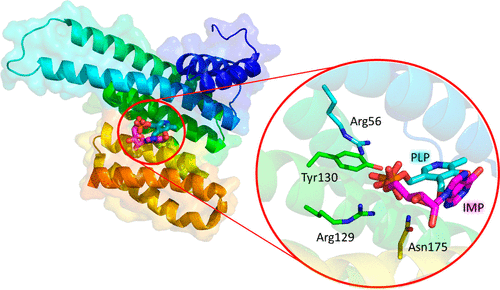当前位置:
X-MOL 学术
›
ACS Chem. Biol.
›
论文详情
Our official English website, www.x-mol.net, welcomes your
feedback! (Note: you will need to create a separate account there.)
Identification of Phosphate-Containing Compounds as New Inhibitors of 14-3-3/c-Abl Protein-Protein Interaction.
ACS Chemical Biology ( IF 3.5 ) Pub Date : 2020-03-20 , DOI: 10.1021/acschembio.0c00039 Leire Iralde-Lorente 1 , Giusy Tassone 1 , Letizia Clementi 2 , Lorenzo Franci 3, 4, 5 , Claire C Munier 6 , Ylenia Cau 1 , Mattia Mori 1 , Mario Chiariello 3, 5 , Adriano Angelucci 2 , Matthew W D Perry 6 , Cecilia Pozzi 1 , Stefano Mangani 1 , Maurizio Botta 1
ACS Chemical Biology ( IF 3.5 ) Pub Date : 2020-03-20 , DOI: 10.1021/acschembio.0c00039 Leire Iralde-Lorente 1 , Giusy Tassone 1 , Letizia Clementi 2 , Lorenzo Franci 3, 4, 5 , Claire C Munier 6 , Ylenia Cau 1 , Mattia Mori 1 , Mario Chiariello 3, 5 , Adriano Angelucci 2 , Matthew W D Perry 6 , Cecilia Pozzi 1 , Stefano Mangani 1 , Maurizio Botta 1
Affiliation

|
The 14-3-3/c-Abl protein-protein interaction (PPI) is related to carcinogenesis and in particular to pathogenesis of chronic myeloid leukemia (CML). Previous studies have demonstrated that molecules able to disrupt this interaction improve the nuclear translocation of c-Abl, inducing apoptosis in leukemia cells. Through an X-ray crystallography screening program, we have identified two phosphate-containing compounds, inosine monophosphate (IMP) and pyridoxal phosphate (PLP), as binders of human 14-3-3σ, by targeting the protein amphipathic groove. Interestingly, they also act as weak inhibitors of the 14-3-3/c-Abl PPI, demonstrated by NMR, SPR, and FP data. A 37-compound library of PLP and IMP analogues was investigated using a FP assay, leading to the identification of three further molecules acting as weak inhibitors of the 14-3-3/c-Abl complex formation. The antiproliferative activity of IMP, PLP, and the three derivatives was tested against K-562 cells, showing that the parent compounds had the most pronounced effect on tumor cells. PLP and IMP were also effective in promoting the c-Abl nuclear translocation in c-Abl overexpressing cells. Further, these compounds demonstrated low cytotoxicity on human Hs27 fibroblasts. In conclusion, our data suggest that 14-3-3σ targeting compounds represent promising hits for further development of drugs against c-Abl-dependent cancers.
中文翻译:

鉴定含磷酸盐的化合物作为14-3-3 / c-Abl蛋白-蛋白质相互作用的新抑制剂。
14-3-3 / c-Abl蛋白-蛋白相互作用(PPI)与致癌作用特别是与慢性粒细胞白血病(CML)的发病机理有关。先前的研究表明,能够破坏这种相互作用的分子可以改善c-Abl的核易位,从而诱导白血病细胞凋亡。通过X射线晶体学筛选程序,我们通过靶向蛋白质两亲性沟纹,鉴定了两种含磷酸盐的化合物肌苷单磷酸酯(IMP)和吡ido醛磷酸酯(PLP)作为人14-3-3σ的结合剂。有趣的是,它们还作为14-3-3 / c-Abl PPI的弱抑制剂,通过NMR,SPR和FP数据证明。使用FP测定法研究了由37个化合物组成的PLP和IMP类似物文库,导致鉴定出另外三个作为14-3-3 / c-Abl复合物形成的弱抑制剂的分子。测试了IMP,PLP和这三种衍生物对K-562细胞的抗增殖活性,表明母体化合物对肿瘤细胞的作用最为明显。PLP和IMP在促进c-Abl过表达细胞中c-Abl核易位方面也有效。此外,这些化合物对人Hs27成纤维细胞显示出低细胞毒性。总之,我们的数据表明,靶向14-3-3σ的化合物代表了针对c-Abl依赖性癌症的药物进一步开发的有希望的打击。PLP和IMP在促进c-Abl过表达细胞中c-Abl核易位方面也有效。此外,这些化合物对人Hs27成纤维细胞显示出低细胞毒性。总之,我们的数据表明,靶向14-3-3σ的化合物代表了针对c-Abl依赖性癌症的药物进一步开发的有希望的打击。PLP和IMP在促进c-Abl过表达细胞中c-Abl核易位方面也有效。此外,这些化合物对人Hs27成纤维细胞显示出低细胞毒性。总之,我们的数据表明,靶向14-3-3σ的化合物代表了针对c-Abl依赖性癌症的药物进一步开发的有希望的打击。
更新日期:2020-04-23
中文翻译:

鉴定含磷酸盐的化合物作为14-3-3 / c-Abl蛋白-蛋白质相互作用的新抑制剂。
14-3-3 / c-Abl蛋白-蛋白相互作用(PPI)与致癌作用特别是与慢性粒细胞白血病(CML)的发病机理有关。先前的研究表明,能够破坏这种相互作用的分子可以改善c-Abl的核易位,从而诱导白血病细胞凋亡。通过X射线晶体学筛选程序,我们通过靶向蛋白质两亲性沟纹,鉴定了两种含磷酸盐的化合物肌苷单磷酸酯(IMP)和吡ido醛磷酸酯(PLP)作为人14-3-3σ的结合剂。有趣的是,它们还作为14-3-3 / c-Abl PPI的弱抑制剂,通过NMR,SPR和FP数据证明。使用FP测定法研究了由37个化合物组成的PLP和IMP类似物文库,导致鉴定出另外三个作为14-3-3 / c-Abl复合物形成的弱抑制剂的分子。测试了IMP,PLP和这三种衍生物对K-562细胞的抗增殖活性,表明母体化合物对肿瘤细胞的作用最为明显。PLP和IMP在促进c-Abl过表达细胞中c-Abl核易位方面也有效。此外,这些化合物对人Hs27成纤维细胞显示出低细胞毒性。总之,我们的数据表明,靶向14-3-3σ的化合物代表了针对c-Abl依赖性癌症的药物进一步开发的有希望的打击。PLP和IMP在促进c-Abl过表达细胞中c-Abl核易位方面也有效。此外,这些化合物对人Hs27成纤维细胞显示出低细胞毒性。总之,我们的数据表明,靶向14-3-3σ的化合物代表了针对c-Abl依赖性癌症的药物进一步开发的有希望的打击。PLP和IMP在促进c-Abl过表达细胞中c-Abl核易位方面也有效。此外,这些化合物对人Hs27成纤维细胞显示出低细胞毒性。总之,我们的数据表明,靶向14-3-3σ的化合物代表了针对c-Abl依赖性癌症的药物进一步开发的有希望的打击。









































 京公网安备 11010802027423号
京公网安备 11010802027423号